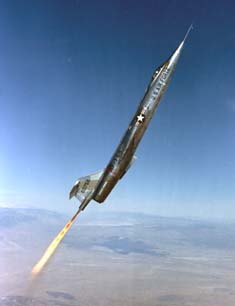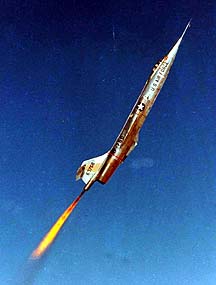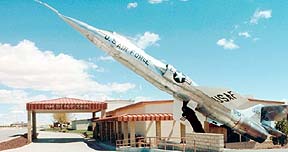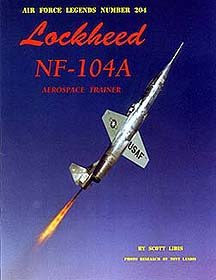
Check out that flame!
(site was at www.batnet.com/mfwright/nf104.html but ISP changed domain to userwebs.batnet.com)
NOTE: This page is under a new domain (mine!) and not all links and images are uploaded yet. I will one by one upload and update.
The official NF-104 webpage with a bio of Bob Smith, lead test pilot for the NF-104, at http://www.nf104.com
 |
| NF-104 zooming skyward, awesome photo,
eh? Check out that flame! |
Back in the 20th century when service stations provided service, women dressed like women, and 4-wheel-drive vehicles were used as 4-wheel-drive vehicles, the USAF added a rocket powered airplane to its inventory. Maybe the NF-104 did not fly as fast and as high as the Mercury, Vostok, or the X-15, however, the NF-104 was far less expensive to operate. Capable of takeoff/landing from conventional runways under its own power, this aerospace plane was a low cost and quick means to skim the boundaries of space. And, it was fully reusable as a trainer for X-15 spaceplane and X-20 DynaSoar pilots (the X-20 was a small delta-wing orbital “space shuttle” that was cancelled in 1963). (Thanks to Tony Landis (contributor of photo research for the NF-104 book) for sending me the color photo above. editor)
The NF-104 is a modified F-104, with a 6,000-pound thrust liquid fuel rocket engine in addition to the conventional jet engine.
 |
| Download this large photo from Edwards AFB gallery (click here) |
This plane can reach altitudes over 120,000 feet where the atmospheric pressure is virtually a vacuum, and for all practical purposes, this is space. Control at these altitudes is accomplished with hydrogen peroxide reaction control jets for pitch and yaw, used to maneuver the craft just like the X-15 and manned space capsules orbiting the earth. When this aircraft flies a ballistic arc, and in going “over the top” the pilot experiences over a minute of weightlessness or no gravity. On November 1963, Major R.W. Smith set an altitude record of 118,600 feet. Smith also took it to 120,800 feet the following month but Guiness does not accept this as it did not exceed by 3% as required by FAI for world records.
Because it flys to the edge of space, pilots of the NF-104 have to wear spacesuits, just like “real” astronauts. Above 60,000 feet, the human body cannot tell the difference between this altitude or 100 miles; you’ll be just as dead without a spacesuit.
So where are the NF-104s these days? Serial #60762 was lost when tested by Yeager (see below), Serial #60756 was scrapped after its rocket exploded, removing half of its rudder, and Serial #60760 is mounted on a pylon by the USAF Test Pilot School at Edwards AFB.
A fourth NF-104 was to be built but never got the rocket on the tail because the project was terminated. Years later, this F-104 became a old boneyard heap of junk from out of Maine, and was purchased by a team working to set a new landspeed record. They are rebuilding and modifying this airframe to travel 800 mph on the ground. Visit their website at http://www.landspeed.com.

The NF104 by the USAF Test Pilot School lacks RCS thrusters. The reason for lack of the thrusters was because they are not on the aircraft anymore. In the late seventies Darryl Greenamyer purchased and modified an F-104 that he planned to use to set several speed and altitude records. This was the famous “Red Baron” F-104. In 1978 he somehow convinced the powers that be at Edwards to “loan” him the nose and wingtips off of the NF-104 on display there with the promise that they would be returned unharmed. He was allowed to remove them and had installed them on his airplane when, in late 1978, he was forced to eject from his aircraft and the plane was destroyed.
The NF sat for several years with a standard fiberglass nose, but recently a metal nose with the long YAPS boom was installed on it and although it still has no RCS thrusters it looks much more appealing now. Website for the USAF Test Pilot School at http://www.edwards.af.mil/tps
The X-37 will use the same rocket engine as the NF-104. Here is a quote straight from the X-37 press release: “The X-37’s on-orbit propulsion is provided by the AR-2/3, a high reliablility engine with a legacy stretching back to the 1950’s. It can produce 7,000 pounds of thrust. Hydrogen peroxide and JP-10, a grade of kerosene commonly used as jet fuel, will propel the X-37 engine.”

NF-104 book by Scott Libis (ISBN 0-942612-97-3) was made available in December 1999. It has very impressive photos, contributed by Tony Landis, including color. This is another in Steve Ginter’s Air Force Legends series and it is another winner. Book used to have a webpage at http://fp3.hughes.net/~fotodude/images/nf1041.html.
This NF-104 book may be available from Aeroplane books at http://www.aeroplanebooks.com
Dr. Menelaos Skourtopoulos modified an 1/32 F-104 kit (Hasegawa) to a NF-104. See http://www.largescaleplanes.com/articles/DrMenelaosSkourtopoulos/NF-104A.htm. Advantage of having a detailed model is the opportunity to capture photos of the aircraft from different angles as seen on this webpage.
“Cosmic Charlie’s” visual account of the NF-104 (from rec.aviation.military newsgroup):
This flight is depicted in the movie The Right Stuff was a perfectly legitimate test mission rather than under the decidedly romanticized circumstances shown in the movie.
Editor’s Note: This is one explanation. Another will follow.
Nominal re-entry profile is to force the nose down with the hydrogen peroxide thrusters, the altitude controllers, so the aircraft enters the atmosphere nose first. Air starts to go through the intake ducts, and once into thicker air, can re-start the engine.
Yeager couldn’t get the nose down when the aircraft came into the atmosphere, and it was pitched up and went into a flat spin. When the aircraft is in a flat spin, there is no air going through the intake ducts, the engine stops and no longer have hydraulic pressure to run the horizontal stabilizer, the aileron or the rudder. A no-win situation.
The following is from William Haynes, grad of the USAF TP School, class of 1956. A classmate, Robert Smith, was pilot of the NF-104 and still holds the world altitude record for ground launched aerospacecraft. Regarding the above explanation, the most egregious is the lack of mention of Bob Smith as primary pilot and the inaccurate description of Yeager’s narrow escape.
Col. Haynes (USAF ret) was involved in the DynaSoar space glider project at the time of Yeager’s bailout, and was shown what happened by Bob Hoey, then Deputy Flight Test Engineer for Edwards.*
Right after Yeager’s accident Bob asked if I would like to know what happened?
He sat me down in a fixed base simulator of the NF-104 that had just been programmed to display the NF’s flight characteristics. He put me at altitude with the nose straight down and said “OK, now jettison the anti-spin chute and recover from the dive.”
I jettisoned it and came forward gently on the stick. The aircraft slowed its nose up rate momentarily and then accelerated nose up and entered a flat spin. With no more anti-spin chute there was nothing I could do, just as Yeager could not either.
Then Bob re-initiated the original conditions and said: “OK, this time when you jettison the chute come full forward on the stick.” I protested that I would go inverted, but he said do it.
I jettisoned and came full forward on the stick. The aircraft hesitated, remained vertical and began picking up indicated airspeed. As it built up I was able to slowly recover and begin a controlled descent.
Bob Hoey then told me that the stability derivatives from Bob’s flights had not been reduced until after Yeager flew. They had tried to get Yeager to wait ‘til they were done and he could train in the simulator but he refused, insisting that “If Smith can fly it, I can.” That’s the real reason that Yeager lost the airplane and almost lost his life.
The real tragedy is that when Yeager failed to recover, the concensus was that the test school could not fly such a dangerous aircraft and the project was cancelled, thereby depriving the school and its students of a tool that would have allowed real cutting edge training and development of some cracker jack test pilots.
By the way, the NF’s jet engine flamed out well before max altitude and could not be restarted until well into the recovery and after lower altitude/denser air was reached.
Mark “Forger” Stucky, a NASA Aerospace Research Pilot from 1993 to 1999, has been researching the NF-104 and X-15 programs for another program he is working on. Below is his account of the 1963 NF-104 event:
I was a student at the USAF Test Pilot School class 89A. During the course of the yearlong school we were also briefed by an old flight test engineer who seriously implied that Yeager had really screwed up during his notorious NF-104 flight and the cause of the accident had been covered up.
The NF-104 had an attitude control system (ACS) that had redundant controllers in each axis. This was to ensure controllability in the event of a single failure. Even in the remote chance of a complete “hard-over” failure, the other controller could be used to completely nullify the extraneous command. It goes without saying that the pilot would have to pay attention to notice an uncommanded rate so he could cancel it out before a high rate had built up. But because of the criticality of such a mission profile a normal pilot would be devoting almost full attention to maintaining the flight attitude, angle-of-attack, and sideslip parameters during the exo-atmospheric phase of flight.
The story I heard was that Yeager just plain screwed up and let the pitch attitude and angle of attack get away from him (mistake #1). This mistake caused the loss of control but that by itself should not have resulted in loss of the jet. Col. Haynes made reference to the lack of stability derivatives for the NF variant and Yeager’s rush to fly without having the data properly analyzed. This may certainly be the case but I wonder just how important the derivatives really were because the spin was recovered at a relatively low altitude where the NF likely wasn’t very different that the standard F-104. I was told by another long time Edwards pilot that Yeager failed to reset the stab trim during the recovery and because of this, could not control the pitch-up when the drag chute was jettisoned (mistake #2). It was mistake #2 that resulted in the loss of the jet.
The biggest mistake in my book and the one that is unforgivable is dishonesty. The current generation of test pilots, pilots, travelers, and society in general are indebted to the great test pilots of the golden age of aviation. We must always strive to learn from the past and unfortunately there are too many cases of whitewashed reports — reports that fail to be critical of the mistakes of the test pilots and flight test team.
As another example, I have heard reports of a pilot induced oscillation (PIO) that occurred in a test aircraft and resulted in a damage causing hard landing. A big contributer to the pitch PIO was the failure of the stability augmentation system (that happens, and it doesn’t mean it’s the pilot’s fault). The aircraft impacted at the bottom of a cycle and the pilot acted like he somehow timed the impact to minimize damage. I’m sorry, but during a PIO you can’t time much of anything in that axis or else you wouldn’t be in a PIO in the first place!
In more modern times you see test pilots much more likely to eat a piece of humble pie for the good of the program. Tom Morganfeld’s PIO on the last flight of the YF-22 is a case in point. There was no denying he was in a horrible PIO. You can argue whether he should have gotten there in the first place but the fact remains he illuminated a very serious problem that, if it wouldn’t have been discovered, would have caused loss of an F-22 in the future (and at a much higher price to fix). The fact that he had the presence of mind to reduce the power to idle and grind to a stop on the runway says plenty for his skills and his ability to think under extreme duress.
Even more true today, a great test pilot career depends more on being in the right place at the right time than on aeronautical pilotage skills. Great test pilots not only recognize this fact; they recognize the historical importance of admitting to their mistakes. Even if your website may not be historically accurate, I hope it will help inspire a future generation to become involved in the noble pursuit of aviation and flight test.
NF-104 webpage: http://www.nf104.com
Early 1960’s USAF News Release for the NF-104 at http://www.wpafb.af.mil/museum/fta/nf104.htm
NF-104 USAF Museum Archives at http://www.wpafb.af.mil/museum/fta/fta597.htm
Lockheed NF-104A and its tail rocket (USAF Museum) at http://aerofiles.com/lock-nf104a.jpg from http://aerofiles.com/_lock.html
Yeager, the ARPS, and the Lockheed NF-104A at http://members.tripod.com/derekhorne/nf104.html
Edwards AFB page on the planes that Yeager flew at http://www.edwards.af.mil/gallery/yeager/docs_html/NF-104.html
This is what you need to wear when flying a NF-104: David Clark spacesuits at http://www.davidclark.com/aerospac.shtml
Pictures of the Lockheed F104 Starfighter including the NF-104 at http://home.planet.nl/~harrylui/usaf
NF104 in french at http://jpcolliat.free.fr/x15/x15-7-2.html
Lockheed NF- 104 moving parts and animated edition from (password required) http://www.indigocactus.com/Flightsim/AirIndigo/downloadstarfighters.htm
Chuck Yeager taxis the NF104 in this photo at http://www.wpafb.af.mil/museum/afp/cey-4.jpg
Chuck Yeager in the NF104 in this photo at http://www.achievement.org/achievers/yea0/large/yea0-043.jpg
Lockheed NF-104 Starfighter by Joe Baugher at http://home.att.net/~jbaugher1/f104_8.html
Landspeed Record Attempt with a F-104 at http://www.landspeed.com
Aviation artist Lou Drendel paintings include the NF104 at
http://www.americanflyers.net/Entertainment/gallery.asp
NF104 painting by Robert Karr at http://www.karrart.com/karrart/2dpost1/nf104.htm
NF-104 Rocket Pilot painting by Lou Drendel, published in Century Series, at http://www.aviation-art.net/rocket%20pilot.jpg
Aviation Art By Douglas Castleman
http://www.dougncart.com/avaition.html
USAF Test Pilot School, NF-104 (http://www.dougncart.com/images/aviation%20art/USAF.jpg), Watercolor - image size:16x24 - $450.00
Robert Smith (Lt.Col., USAF), Primary NF-104 pilot
Charles Yeager (Brig. Gen, USAF), ARPS Commandant
Jack Woodman, Lockheed test pilot (first rocket starfighter pilot)
Bill Brown, Lockheed test pilot
Bob Rushworth, (USAF), X-15 pilot
John Blaha (Col., USAF), NASA Astronaut, in 1971 piloted the NF-104 to 104,400 feet.
Roy Bridges, Jr. (Col., USAF), NASA Astronaut
Robert Gilliland, Lockheed test pilot (first SR-71 pilot)
Fred Watts (flew over 106,000 ft)
Alton D. Slay (Brig. Gen, USAF)
Robert Lilac (ARPS Class 67-B), climb angle 41 degrees to 101,830 feet
Harry Blot (Capt. later Lt. Gen, USMC)
Mike Loh (Capt, later Gen, USAF)
Maximum zoom flights (altitude, number) for test pilots in order of their first flight:
After Chuck’s crash, the airplanes were supposably restricted to flight by only Robert Smith, and restricted to altitude/airspeed within aerodynamic regimes (however, there were flights beyond this regime, i.e. Blaha’s flight).
Brig. Gen. Alton D. Slay was an energetic and hands-on AFFTC commander from Dec. 6, 1968 to July 13, 1970. During his tenure here, he frequently took a hand in demonstrating the capabilities of the Centerís aircraft. On June 4, 1970, he zoom-climbed an NF-104 to 104,000 feet, thus becoming the first Air Force general officer to fly above 100,000 feet.
Probably the last flight of the NF-104 was in 1971.
I believe, that $7,000,000 project was unbelievable in expanding the bird’s zoom altitude by over 40%, while making it capable of control and survival outside the realm of aerodynamic flight into the outer few percent of earth’s atmosphere. The view from apogee of its ballistic path, looked just like the pictures from space of the pitch black sky, earth’s halo glow and circular horizon.
The problems encountered in the NF test flights were created by flight or ground-crew personnel. I can never remember one being a shortcoming in the aircraft or its design. The airplane was a most amazing and successful conversion, in my opinion, and that is a fact that needs telling.
Of course, the NF had a serious role because at that time the Dynasoar Space Plane was being designed and would have flown were it not cancelled by the Secretary of Defense McNamara in late 1962. Also the technology of the Scramjet made it likely that we would be flying well over 100,000 feet in an air-breathing engine. With the advantages of skipping on the edge of the atmosphere, there were great expectations and the concepts were not pipe-dreams. The Scramjet technology is valid, the usefulness of such craft seems to be the issue.
